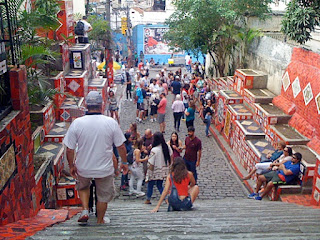
The palace of Peter 1 and Peter 2nd, the first Portuguese rulers in Brazil. It's not a very ornate palace but was the only building big enough in the city to be able to house the royal entourage when they moved here from Portugal. The area outside is used as a public market on weekends.
Old churches mix with the new office towers in Rio.
A statue of one of the famous freedom fighters in Brazil. They show him positioned like a saint, but he was a revolutionary. Tiradentes is the name and the legislative palace behind him is named for him.
A closeup of a cannonball tree blossom.
Jason looking at a cannonball tree. The little balls grow to be the size of actual cannon balls and they are very hard, dense, and heavy.
You can see some bigger cannon balls on the trunk of this tree.
An ornate building undergoing rennovation.
The Municipal Theater, with new green and gold highlights on the roof. It's quite beautiful, really.
The gov't building where the actual work gets done. The clock tower on the right works, as does the calendar tower on the left. Our guide didn't know how the calendar one worked with different number of days in different months.
There seem to be lots of buildings that curve around corners or come to a point in a triangle. Makes for interesting architecture.
Lots of fancy buildings and this ornate lamp in a park corner.
The walls along the street are considered art. This is walking up to the Selaron Steps in Lapa.
Different sections are given to different artists to paint as they see fit.
They certainly are colorful, even if we don't know what they are or what they mean.
Some of the artwork is quite good. These folks set out jewelry and trinkets for sale on the sidewalks.
Looking at the Selaron Steps in Lapa. Jorge Selaron was an artist who decided to tile these steps as an art project. He used tiles in the colors of the Brazilian flag to start with, but soon realized that wouldn't be practical. He expanded his use of colors and the origins of the tiles. It became an ongoing art project and lasted until he died in Jan. 2013.
There are thousands of different tiles laid into the 215 steps and their surrounding walls. The eclectic mix of tiles is fascinating!
These hand-painted tiles by Selaron incorporate a pregnant black woman, and there are many of them in the space of the steps, but nobody knows who she is or what importance she held--one of the mysteries that will remain now that the artist is dead.
Jason studying a section of tiles. Folks climb onto the various levels of the walls to have their photos taken.
Looking down the steps. You can see Jason in the blue shirt talking to some friends. We walked up and then back down the stairs and back up again. The best viewing is definitely going up.
Walls of tiles in so many colors and with so many different subjects.
American icons of Coca-Cola and Michelin.
Some of the tiles are 3-D, too. The shell bulges out of the wall.
Country flags, Michael Jackson, Bob Marley and mermaids all mix on this section.
This cute little tile is of the yellow tram that still runs today from Lapa across the old aqueduct and back. We rode the tram--it's free.
The three stooges rated several tiles.
The top row is all of those pregnant black woman tiles.
Tiles grouped to represent a chocolate bar with a bite out of it. Clever.
Tarzan. Cool.
Beer featured in this one.
The simplicity of the design of these flowers caught my eye.
This is a big corner on the stairway and folks pose here for their photos. I was lucky to get the shot with no strangers in it.
The graffiti at the top of the stairs.
The tile from Portugal, the parent of Brazil.
This ducky face made me smile.
Africa with the different countries in different colors.
One of the alcoves just off the main steps.
Such a variety made it very interesting.
A partial explanadion.This aqueduct used to carry water from the hills into the center of town. Now it is a rail line for the little yellow tram you see on the top.
The big beehive-shaped church of St. Francis of Assisi.in dowtown Rio. The flat panels running up the side are all stained glass.
The bell tower for the church sits in the lot next to it at ground level.
Folks on the free yellow tram ride.
You should recognize the little yellow tram from the tile.
Looking down from the tram as we crossed a city square. You can see the buildings in disrepair with the paintings on the sides.
Some old homes along the tram route. The well-to-do moved into this neighborhood known as Santa Theresa when the diseases came to central Rio. Sta. Theresa is up on a hill and had cleaner air.
Paintings along the walls of the homes on the tram route. The streets still allow cars to travel on them along with the tram, too.
This rat painting was on the wall of the tram stop.
Another tram station painting.
We rolled past these funky figurines made of scrap metal as we headed down the hill on the tram.
An entire side of a building dedicated to a painting.
A view from the aqueduct part of the tram.
Heading home on the Metro, we were entertained by two ladies playing a flute and accordion. Rio is nothing if not interesting!!






















































No comments:
Post a Comment